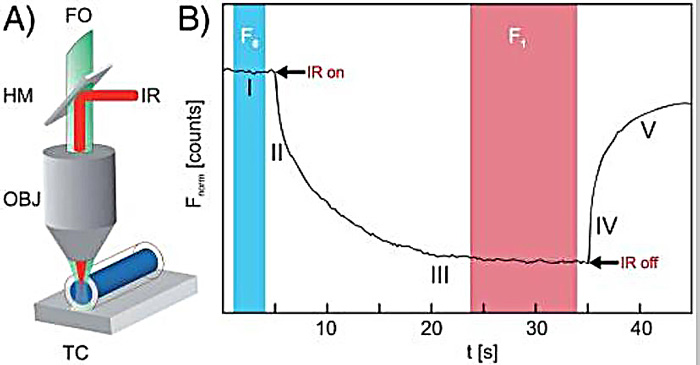MT for Binding Affinity Measurement
Measurment principle of MST
Microscale thermophoresis (MST) is a relatively new technique of studying the interactions between biomolecules. The assay is based on the detection of change in fluorescence of a target induced by temperature, which means any change of the chemical micro environment of the fluorescent probe will result in a relative change of the fluorescence detected. Therefore, the range of the variation in the fluorescence signal correlates with the binding of a ligand to the target, allowing for quantitative analysis of molecular interactions on the microliter scale with high sensitivity.

Fig.1 The application of higher-throughput plate-based methods in thermal shift increases assay throughput. (Seide, S.; et al. 2019)
Application of MST Technique
Microscale thermophoresis measures the binding of biomolecules and provides important data for drug discovery.
- Precise affinities (KD, dissociation constant) of interaction between any kind of biomolecules (proteins, DNA, RNA, peptides, small molecules, fragments and ions) in any buffer including serum and cell lysate or in competition experiments, such as substrate and inhibitors.
- Study multicomponent reactions including the competitive effects between multiple binders of your targets.
- Analyze the complex formation, order of assembly and interfering.
- Study the stoichiometry by determining the number of binding sites of biomolecules and discriminating between different binding sites on a target of interest.
- Provide thermodynamic parameters, such as binding energetics dG (free energy ), dH (enthalpy) and dS (entropy).
- Tell whether the protein aggregation is induced by ligand binding and separate it from true binding events.
Benefits of MST
- High accuracy and quality controlled are achieved through online detection of sample aggregation, sticking and precipitation, etc.
- Unlike traditional methods, small quantities of samples (pM/nM concentrations and less than 4 μL of volume of reaction solution) is required in MST.
- Time-saved and cost-effective: The MST measurement can be accomplished in a rather short time.
- Monitor the binding and biochemical activity of biomolecules under close-to-native conditions which is label-free setup completely native and no protein immobilization required.
- High sensitivity: MST assay can detect a wide range of binding interactions of from mM down to pM, from ions up to nano particles.
MST Services
Combing the dedicated expertise of MST and our professional operations, we have confidence in bringing multiple services to our customers in different stages of drug discovery.
Hit identification
We conduct high-throughput screenings of thousand of compounds per time with just a couple of hundred microliters of protein solution required with the use of MST in the hit identification.
Assay development
Our assay development for microscale thermophoresis covers assay setup, required technical parameters setup, selection and establishment of positive and negative controls, as well as robustness testing and high-throughput setup.
Hit validation & characterization
We apply MTS to monitor a number of biophysical parameters including binding affinity (we study this index under various conditions and investigate break down multi-site, secondary binding, influence of co-solutes and co-ligands), kinetic parameters and thermodynamic parameters (ΔG, ΔH, ΔS) of hit-target interactions.
We have abilities in revealing structure and quantifying the affinity of their interactions utilizing these critical information.
Hit-to-lead
Our team conducts further study on more binding parameters, like stoichiometry and possible competition assay (binding site confirmation, hit specificity and mode-of binding investigation) for candidate drugs.
Fragment-based screening
We also utilize MST successfully in fragment-based screening and enable to provide related services for the detection of fragment binding, such as binding and competition assays (including study the affinity values and map the ligand binding site), completing characterization of protein-fragment interactions, designing fragment growth and target-lead interactions, etc.
Our Capabilities of MST
- We have established an advantageous MST platform which enables to rapidly screen hundreds of samples per day with very low amounts of sample and can be applied in a wide range of proteins.
- Our team is capable of enhancing the chances of drug-development success by providing orthogonal evidence of target engagement through triaging and characterizing HTS hits, and identifying the compounds which are suitable for further investment.
- We perform larger screening projects in a label-free manner with the use of fluorescently labeled tool, which avoiding attrition at later stages of drug development.
- Our microscale thermophoresis assays are supported by an advanced software for data acquisition and analysis which ensures the accuracy of data processing.
Equipment
NanoTemper Monolith NT.115
Reference
- Seide, S.; et al. Microscale thermophoresis quantifies biomolecular interactions under previously challenging conditions. Methods. 2013, 59(3): 301-315.
※ It should be noted that our service is only used for research.

One-stop
Drug Discovery Services
- Experienced and qualified scientists functioning as project managers or study director
- Independent quality unit assuring regulatory compliance
- Methods validated per ICH GLP/GMP guidelines
- Rigorous sample tracking and handling procedures to prevent mistakes
- Controlled laboratory environment to prevent a whole new level of success
Online Inquiry

